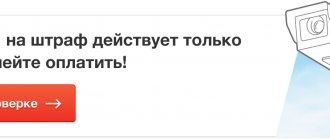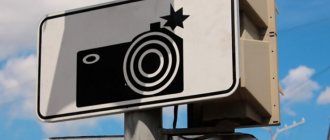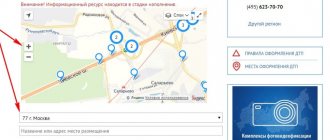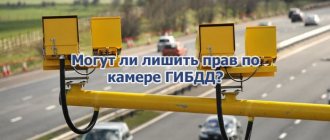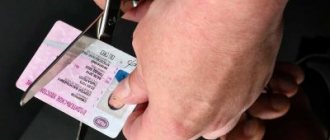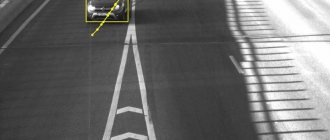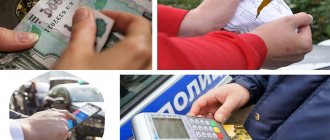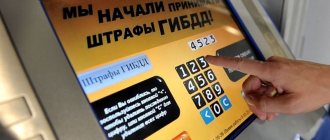How traffic police fines are recorded with photos
How cameras and traffic police officers work. Let's look at the most common case - the camera looks at the lane and records violations: for example, driving into oncoming traffic. As soon as the car is in the oncoming lane, the camera sees that the car is driving against the main flow and takes a series of photographs or video recordings.
After this, the materials are sent to the Center for Automatic Recording of Administrative Offenses (CAFAP), a division of the traffic police. There, the inspector checks from photographs whether the driver really violated and whether the camera made a mistake. If a traffic police officer accepts the driver’s actions as a violation, he signs the resolution and sends it to the traffic police database.
Then the information goes to the information system on state and municipal payments (GIS GMP). This is the information base of the Russian Treasury; it stores all information about payments that have been received or should be received by the treasury. Fines, taxes, penalties from bailiffs - everything is in this database.
Within 3 days, the car owner is sent a decision by mail or he himself checks his fines online and sees a new one.
Why is there not always video recording? The number of photo and video materials and their shelf life depend on the technical equipment of TsAFAP - it is different in each region. For example, in Moscow there is a budget for the purchase and maintenance of large data servers. A server is a powerful computer with a large amount of memory. The more servers, the more opportunities to store photos and videos and do it for a long time. Therefore, in Moscow and the region, even video recordings are stored for up to 3 years.
But if a region has purchased small-volume servers, photos may not be stored for long: in regions this period is often from a week to six months. In this case, the video recording may not be saved at all.
What types of cameras are there? Most often, cameras are installed on supporting structures - poles, overpasses, bridges. There are other ways of arrangement. Let's look at them all:
- stationary - the camera is mounted on a pole or a special mast. Usually located in the city or on busy roads;
- mobile - the camera stands on a tripod. Inspectors install it when they check cars in remote areas of the region - where it is inappropriate to install a stationary camera;
- transportable - the camera is installed on public transport or a special car. This method is almost always used to check whether parking has been paid and whether there are violators in the public transport lane.
Methods of installing cameras: on a pole, tripod, in a special vehicle. Source: simicon.ru
Public transport or special vehicles are equipped with cameras that record violations of parking rules and traffic in designated lanes. Source: simicon.ru
Where can I see photos from video cameras?
Often there is a need to see footage from cameras of the traffic police of the Ministry of Internal Affairs (formerly the traffic police). For this you can use:
- Materials from the resolution . More often they are presented in the form of photographs, which the alleged violator receives along with a decision to impose a fine for violating traffic rules. Photos and video materials indicate the date and place where the violation was recorded.
It is possible and necessary to rely on this information, but all fully filmed material is stored digitally on state portals. In some situations, this information can play an important role in proving the innocence/guilt of the alleged offender.
Data obtained from specialized sites . To view video and photographic materials, you can use some websites and mobile applications: the official website of the State Traffic Safety Inspectorate, State Services, mobile applications.
There are many more sites and applications that are not official. Everyone decides for themselves whether to trust such resources or not, but still official sources of information about photo and video materials are more reliable in any situation.
Why is photographic recording of the violation necessary?
The camera can monitor the traffic situation 24 hours a day all year round. The inspector does not notice many violations while drawing up a protocol, warming up in the car or having lunch. Here are some more reasons to use cameras.
Objective recording of violations. The camera records what appears to be a violation. Whether this was actually a violation is decided by the traffic police officer. He will look at all available materials and make a decision. If there is still a violation of the rules, the inspector will issue a fine.
Ability to control more roads. The camera can be placed on remote sections of roads with extreme weather conditions.
Recording several violations at once. All traffic cameras have this function. For example, cameras of the Cordon model can simultaneously detect:
- over speed;
- driving into the oncoming lane or tram tracks in the opposite direction;
- driving on the median;
- driving in the public transport lane;
- driving on the side of the road;
- driving trucks where prohibited;
- passing through the stop line.
Makes it easier to find violators and bring them to justice. There are cameras that are configured to search for specific cars by license plate number. The traffic police patrol uses them to track the movement of the offender’s car.
The opportunity to prove your innocence. The inspector rarely looks at all the photos, much less the video from the camera: he doesn’t have time for that. And sometimes the camera makes mistakes - it incorrectly measures the speed or calculates the license plate number of the car.
The camera sends a series of photos or video recordings to the server. If the camera or inspector makes a mistake, the driver can request the entire series of photos or videos that show the mistake and prove his innocence.
What violations are recorded by cameras?
The capabilities of the camera depend on the customer of the equipment - the city administration. If the area is hazardous or several traffic rules are violated at once, the customer asks to enable one or another function on the camera.
Here is a complete list of violations recorded by traffic cameras:
- driving on red;
- driving in reverse;
- leaving the stop line;
- violation of traffic rules through a railway crossing;
- turning from the second row - failure to comply with the rules of maneuvering;
- driving on the side of the road, sidewalk, bike path;
- over speed;
- driving into the oncoming lane;
- driving in the public transport lane;
- violation of parking rules;
- non-payment of parking;
- not allowing pedestrians to pass;
- violation of transportation of oversized cargo.
In Moscow, from the beginning of 2021, the traffic police began testing cameras that can track violations: unfastened seat belt, lack of compulsory motor liability insurance policy and talking on the phone.
Rules for imposing traffic police fines with photo recording
Minimum possible fine. The Code of Administrative Offenses (CAO) often has a range of fines for one violation. For example, for failure to allow a pedestrian to pass, the minimum fine is 1,500, the maximum is 2,500 rubles. If the violation was noticed by a camera and not an inspector, the fine under the Administrative Code will be minimal.
Deadlines for issuing traffic fines with a photo of the violation. The traffic police officer is obliged to make a decision on photo or video materials within 15 days from the day he receives them.
Fine for radar detector in Russia: how much does the driver face?
The use of radar detectors (not radar detectors) in Russia is currently not prohibited as such. However, car owners traveling abroad should take into account that the very presence (and not even the use) of a radar detector in a car is prohibited in European countries, such as Finland, Denmark, Estonia, Austria, Belgium, Hungary, Lithuania, Luxembourg, Poland, Switzerland , Spain. For having a radar detector, a large fine is imposed, and you may also encounter problems with further obtaining a visa to the country.
Despite the absence of a direct ban on the use of radar detectors, you can still get a fine for using them. The fact is that clause 7.3 of the traffic rules prohibits the placement of objects and devices in the cabin that impair visibility. A radar detector installed on the windshield can become a reason for drawing up a protocol under Part 1 of Art. 12.5 Code of Administrative Offenses of the Russian Federation.
Code of Administrative Offenses of the Russian Federation Article 12.5. Driving a vehicle in the presence of malfunctions or conditions under which the operation of vehicles is prohibited 1. Driving a vehicle in the presence of malfunctions or conditions under which, in accordance with the Basic Provisions for the admission of vehicles to operation and the duties of officials to ensure road safety, the operation of a vehicle means are prohibited, with the exception of malfunctions and conditions specified in parts 2 - 7 of this article, -
entails a warning or the imposition of an administrative fine in the amount of five hundred rubles.
Naturally, if you do not agree with the violation, you should report this to the traffic police inspector. In this case, a protocol on an administrative offense will be drawn up, which can be appealed within the period established by law.
- Everything about replacing a driver's license
- Everything about car registration
- Getting your driver's license for the first time
- All about deregistration with the traffic police
- Passing technical inspection 2019
- New rules for registration of road accidents
- Drawing up a purchase and sale agreement
- Acura
- Audi
- Aurus
- Bentley
- BMW
- Bugatti
- Cadillac
- Chery
- Chevrolet
- Citroen
- Ford
- Geely
- Genesis
- Haval
- Honda
- Hyundai
- Infiniti
- Jaguar
- Jeep
- Kia
- Lada
- Land Rover
- Lexus
- Mazda
- Mercedes
- Mitsubishi
- Nissan
- Opel
- Peugeot
- Porsche
- Renault
- Skoda
- Subaru
- Suzuki
- Toyota
- UAZ
- Volkswagen
- Volvo
- All brands
For drunk drivers, the presence of a minor child under 16 years old in the car will become an aggravating circumstance. Refusal to undergo an examination will now be punished more severely than for driving while intoxicated.
Violation Will Now Driving a vehicle by a driver while intoxicated 30,000 ₽ and deprivation of rights for 1.5–2 years 30,000 ₽ and deprivation of rights for 1.5–2 years Driving a vehicle by a driver while intoxicated (with a minor in the car) 50,000 ₽ and deprivation license for 2–3 years - Transfer of control to a person in a state of intoxication 30,000 ₽ and deprivation of rights for 1.5–2 years 30,000 ₽ and deprivation of rights for 1.5–2 years Refusal of the driver to undergo a medical examination for intoxication 40,000 ₽ and deprivation of rights for 2–3 years 30,000 ₽ and deprivation of rights for 1.5–2 years Refusal of the driver to undergo a medical examination for intoxication (with a minor in the car) 50,000 ₽ and deprivation of rights for 2–3 years -
For transporting a child without a child seat, if its use is mandatory, the punishment will be more severe.
Violation Will Now Violation of the rules for the transportation of goods or rules of towing 500 ₽ 500 ₽ Violation of the rules for transporting people 500 ₽ 500 ₽ Violation of the requirements for the transportation of children 3000 ₽ 3000 ₽ Violation of the requirements for the transportation of children with the mandatory use of restraints 5000 ₽ - Violation Will Now Violation of traffic rules, resulting in minor harm to health 2500-5000 ₽ or deprivation of rights for 1–1.5 years 2500-5000 ₽ or deprivation of rights for 1–1.5 years Violation of traffic rules resulting in causing moderate harm to health 10000-25000 ₽ or deprivation of rights to 1.5–2 years 10,000-25,000 ₽ or deprivation of rights for 1.5–2 years Leaving the scene of an accident Imprisonment for 1–1.5 years Imprisonment for 1–1.5 years Failure to comply with the requirement to prohibit the use of alcohol or drugs after an accident or after stopping the vehicle at the request of the police before conducting an examination 30,000 ₽ and deprivation of rights for 1.5–2 years 30,000 ₽ and deprivation of rights for 1.5–2 years
Now the draft of the new Code of Administrative Offenses is at the stage of public discussion, then it must be submitted to the State Duma for approval. Meanwhile, the increase in fines, primarily for speeding, has already been criticized by both deputies and the new prime minister.
The document describes in detail all the problems of brake systems, for which inspectors have the right to issue fines. There is no point in listing them all, because only specialists can detect a specific problem.
The most important thing is that brake fluid (and any other fluid in general) should not leak, and compressed air should not come out of the brake chambers. The brakes must operate clearly and quickly, and the ABS must be in full working order.
Otherwise, you cannot go out on the road for your own safety.
The requirements for steering are also adequate and understandable. You should not drive a car if the amplifier provided by the manufacturer is faulty (or missing), fluid is leaking in the hydraulic system, the steering wheel is very loose or turns spontaneously. You should not adapt to such “features”, as some experienced drivers prefer to do. Now a fine will be imposed for a malfunction of the steering system for at least one indicator.
The most important thing, which is often ignored by irresponsible drivers, is that it is forbidden to “modify” or change the headlights - they must clearly comply with the vehicle design requirements established by the manufacturer. For installing non-standard LED and xenon headlights in 2021, violators will face a fine of 500 rubles, although last year there was no such clause in the document.
In addition, next year they plan to ban the covering of headlights with optical elements, including film.
The car must have brake lights, side lights and side lights working.
What to do if you receive a fine without a photo
Why do fines arrive without photographs? This happens if the fine comes for violating parking rules. In all regions except Moscow and the Moscow region, there is no photograph in the resolution for this violation. Sometimes a photo does not get into the GIS GMP due to a technical failure. Read more about all the cases when a dubious fine is received in our detailed analysis.
Where to check traffic police fines online with photos. This can be done on the State Services website, but you need to register and confirm your identity, and to do this go to the MFC. Instead, check the fine on the Traffic Police Fines website.
You will need a license plate number, registration certificate and license numbers. Leave your email so you don't miss notifications about new fines.
WHO said coronavirus did not come from a laboratory in Wuhan
| Article of the Administrative Code | Fine or other punishment |
| 12.36.1 The driver's use of a telephone while driving a vehicle that is not equipped with a technical device that allows hands-free negotiations | 1500 rubles |
| Article of the Administrative Code | Fine or other punishment |
| 12.7 part 1 Driving a vehicle by a driver who does not have the right to drive a vehicle, with the exception of training driving | 5,000–15,000 rubles |
| 12.7 part 2 Driving a vehicle by a driver deprived of the right to drive a vehicle | 30,000 rubles, or administrative arrest for up to 15 days, or compulsory work for 100–200 hours |
| 12.7 part 3 Transfer of control of the vehicle to a person who obviously does not have the right to drive the vehicle, with the exception of training driving, or who has been deprived of such right | 30,000 rubles |
| 12.8 part 1 Driving a vehicle by a driver who is intoxicated, if such actions do not constitute a criminal offense | 30,000 rubles with deprivation of rights for 1.5–2 years |
- Fines for DVRs and radar detectors: commentary from the traffic police - 08/27/2020
- Fine for DVR from May 26, 2021 - 05/25/2020
- The traffic police denied fines for the lack of a DVR - 05/08/2020
- The traffic police denied fines for radar detectors - 10/30/2018
- Rules for the return of rights after deprivation from October 20, 2021 - 10/13/2018
- They want to simplify the issuance of the “Disabled” badge - 10/11/2018
- The draft law on compulsory motor liability insurance was sent to the Government - 10/10/2018
- Will cars older than 5 years be banned? — 09/10/2018
- On October 7, new car registration rules came into force - 06/10/2018
- Traffic rules changes from 2021 - 12/27/2018
- License exam 2021: 14 important changes - 12/25/2019
- Traffic police fines from January 1, 2021 - 11/16/2020
- Will it be possible to get a license from 16 or 17 years old in 2021? — 01/05/2021
- Amendments to the traffic police exam have been postponed from October 1, 2021 - 05/23/2020
What are the consequences of unpaid traffic police fines with photos?
The case will be handed over to the bailiffs. This will happen 70 days from the date of the decision if the fine is not paid. They give you 10 days to appeal the fine and 60 days to pay. The date can be viewed when checking.
In the upper left corner is the date of the decision, below is the date of violation
The fine will be increased by 1000 rubles. When the FSSP employee receives a copy of the resolution, he will begin enforcement proceedings. A decision about this will be sent to the driver - you can check it at the State Registration Office. If the driver receives a decree and does not pay the fine after 5 days, the bailiff will issue an enforcement fee - 7% of the debt amount, at least 1000 rubles.
Now the driver must pay the fine, plus a fee - he has another 70 days to do this. In this case, you no longer need to pay a fine to the traffic police - only to the bailiffs by their order. This document will also be reflected when checking on the “Fines” website.
For a bailiff's fine, the resolution number begins with the numbers 322
They will withdraw money from the account. This is possible if the driver ignores the order of the bailiffs and does not pay the fine. In this case, the bailiffs refer the case to court. If the debtor does not appear at the meeting, the decision will be made without him, and not in his favor. The judge, after considering the case, can make one of several decisions. Most often, money is forcibly collected from a bank account.
Rights are revoked. This measure can be chosen for the debtor if the debt is more than 10,000 rubles.
Movement will be restricted. Such a sanction may be applied if the debt is more than 30,000 rubles.
They will be arrested or ordered to work. At the meeting, they may be sentenced to 15 days of arrest or forced labor for 50 hours.
Read about all the consequences of failure to pay traffic fines in our other article.
Checking fines from cameras
Fines from the traffic police from video recording cameras often bring problems to vehicle owners.
A notice with copies of documents is sent to the place of registration, but the sending system is far from perfect. Some car owners often do not even realize that a decision has been made against them. At the same time, sanctions accumulate, and if the amount of the debt exceeds 10 thousand rubles, then a forced collection procedure is initiated against the citizen. As a rule, restrictions on movement are introduced and bank accounts are blocked. As a drastic measure, the car owner may receive a ban on transactions with movable property.
To avoid negative consequences, experts recommend checking for sanctions through the official website of the State Traffic Inspectorate or the State Services portal.
Official website of the traffic police
On the fines website from cameras 590 and the official traffic police portal, you can independently check the presence of unpaid receipts. The web resource is automatically linked to a single database, which receives all relevant information about traffic violations.
Step-by-step instructions for checking the resolution from the State Traffic Inspectorate:
- open the “Service” section;
- select the “Check fines” tab;
- enter information in the form that opens about the owner and information about the vehicle;
- get an online report of unpaid invoices.
The service is provided free of charge. You can also make payment on the website. If the system showed the presence of a fine in the database through a video camera, then leaving it unpaid means receiving more severe penalties.
When the owner is sure that he is right, then it is necessary to file a complaint. Compliance with bureaucratic rules of procedure significantly increases the chances of winning a lawsuit in court.
Unified website "State Services"
Information about traffic violations is provided by the State Services website free of charge. To check the current resolution from the State Traffic Inspectorate you should:
- select the “Transport and driving” section
- click on the “Car and traffic fines” tab;
- indicate in the form the information of STS and VU;
- wait for the request to be processed.
When paying on the portal there is a 30% discount.
Using these methods, a citizen can timely receive up-to-date information about the presence of a fine from the camera for speeding and other violations. The average time for receipt of notification is 18-20 days. But due to the complexity of the procedure and possible delivery failures, the use of electronic platforms for verification and payment is more effective and mitigates the negative consequences.
Therefore, you should not wait for the “chain letter” to arrive, but check the unpaid bills yourself. According to Article No. 32.2 of the Code of Administrative Offenses of Russia, the transfer of funds must be made before the expiration of 60 days. Along with this, in the specified article, part No. 1.2. It is stated that when depositing funds within 20 days, a citizen receives a 50% discount.
Read also: Law on elections in the Russian Federation
It is noteworthy that if the letter is returned to the sender, i.e. to the traffic police, then the notification is considered delivered. Thus, a citizen is obliged to pay sanctions for violating traffic rules.
When can you challenge a traffic police fine with a photo of the violation?
The cameras focus only on the car's registration plate. It happens that the camera makes a mistake, and the traffic police officer does not have time to check the number and compare it with the brand - as a result, the driver receives an erroneous fine. Let's consider such cases.
The owner of the car was not at the scene of the violation. The camera does not see who is driving - the driver could be a company employee who is temporarily using a company car. To prove this, you will need a certificate of employment and testimony from the real driver.
There is another car in the photo. It happens that an attacker puts a fake number on a car - it matches the number of a law-abiding driver. A record from the registrar that the driver was in another place at the time of the violation, for example, on a business trip or at a children’s party, will help prove innocence. Airplane tickets, a certificate from a hotel, or tickets from a performance can help prove innocence. Testimony from witnesses will also be helpful.
There is evidence that there was no violation. For example, the video recorder in the car’s interior recorded that the driver was forced to enter the oncoming lane to avoid an accident.
How to dispute. Write a complaint addressed to the head of the department whose employee made the decision. This must be done within the first 10 days from the date of the decision. If there are DVR recordings, write them down on a flash drive and attach them to the complaint.
The complaint must be considered within 10 days
We wrote more about how to appeal fines from cameras in our other article.
A fine for a radar detector in Russia is not provided for by law.
If you don’t want trouble in the form of a fine, then all the wheels that are installed on the car must exactly comply with the vehicle’s operational documentation (size, speed category, load-bearing capacity). In 2021, there will be a direct ban on driving a car with unsuitable wheels.
The use of out-of-season tires is also prohibited. That is, in the summer it is strictly forbidden to move on wheels with spikes, and in the winter - without them. But, due to different climatic features in the regions of the country, these points will be adjusted by period.
The driver will receive a fine if:
• not all wheels have winter tires;
• the tread height is equal to the height of the wear indicator;
• tires of different sizes, tread patterns, designs, reconditioned and new are installed on one axle;
• instead of spool valves, other devices are installed;
• tires have damage (cuts, punctures), delamination in the frame, peeling;
• at least one fastening bolt is missing, there are visible violations of the fastening holes.
In general, according to Anton Shaparin, vice-president of the National Automobile Union, it is very important now to combat the welding of discs. This service is popular at tire shops, but in reality it is dangerous: it increases the risk that the disc will burst while driving. Therefore, traffic police officers now have the right to examine the integrity of discs when they brake a vehicle on the road.
If you are attaching a trailer to a car or towing another vehicle, then the most important thing is that the parts of the coupling devices and fastenings, as well as chains or cables, are in place and in good condition, without deformation or cracks. All connecting elements must be tightened and secured, in good condition, without damage. Parts of coupling devices must meet the dimensional characteristics.
If the car engine is faulty, and this is noticeable to the naked eye, without special devices, then this also threatens with a rather large fine. For example, the smokiness of the exhaust gases is increased, there are liquid leaks or gas leaks, fastening parts of the power system elements are missing or weakened, instrument readings do not correspond to the standard, or the noise level of the exhaust gases exceeds the required values.
- Popular materials
- all materials
- All tags
- latest comments
- All blogs
And this device already belongs to the category of special technical means and is prohibited from free circulation. “Anti-radar,” unlike a radar detector, not only detects police cameras and radars, but also jams their signal, thereby preventing the vehicle’s speed from being measured. Such a game of playing special agent can end quite disastrously, especially if the device damages police equipment. In this case, the violator will be required to compensate everything. If the inspector simply discovers a “radar detector” attached to the windshield, then the driver, according to Article 13.3 of the Code of Administrative Offenses of the Russian Federation, faces a fine of 1,000 to 2,000 rubles and confiscation of the device.
Photos from Internet resources
- #test
- #accident in Nizhny Novgorod
- #traffic police
- #incidents
- #accident in Nizhny Novgorod region
- #osago
- #lifehack
To avoid a fine for poor visibility, you need to adhere to several rules:
- Firstly, you should hang any objects not on the windshield, but on the front instrument panel.
- Secondly, when meeting with a traffic police inspector, you should always photograph the location of the device so that if you go to court, you can provide evidence of your innocence.
The authorities are inclined to introduce a fine for having this item in the car, but this issue has not yet been resolved. And until the moment he decides, every driver should know that he has the right to use the device if it does not interfere with visibility.
- Prices
- Characteristics
- Test Drive
- Four-wheel drive
- Trunk
- Photo
- Video review
- News
- Lada Vesta Cross sedan
- Prices
- Characteristics
- Test Drive
- Trunk
- Photo
- Video review
- release date
- News
He recalled that new cars do not undergo technical inspection for the first four years, then this procedure should be carried out every two years, and for cars older than 10 years - annually. In addition, fines have been introduced for falsifying diagnostic cards. Drivers face 5-10 thousand rubles, and those who issued a fake - up to 300 thousand (or up to six months of arrest).
In 2021, the expert recalled, the rules for passing exams for a driver’s license have also changed. So, if a future motorist fails his driving test in the city, he will also fail on the test site. In addition, the instructor will be able to choose any route for the examinee along permitted streets.
In addition, from January, only electronic vehicle passports will be issued for newly registered cars, and the owner will receive an extract from the database. Also this year, the registration of road accidents under the European protocol continues.
Yes, all new fines introduced from January and March 2021 can be paid at a discount. In the first 20 days from the date of the decision it will be 50%.
The same rule applies to most existing fines that have not changed. Below is a complete list of them.
A state sign is considered non-standard if it does not meet the requirements of the law or is unreadable.
| Article of the Administrative Code | Fine or other punishment |
| 12.2 part 1 Driving a vehicle with unreadable, non-standard state signs or signs not according to the standard | warning or fine 500 rubles |
| 12.2 part 2 Driving a vehicle without state signs, without signs in the places provided for this, or with modified signs or with a device for hiding them | 5,000 rubles or deprivation of rights for 1–3 months |
| 12.2 part 3 Installation of obviously forged government signs on a vehicle | for drivers - 2,500 rubles, for officials - 15,000–20,000 rubles, for legal entities - 400,000–500,000 rubles |
| 12.2 part 4 Driving a vehicle with obviously false state signs | deprivation of rights for 6 months - a year |
| Article of the Administrative Code | Fine or other punishment |
| 12.8 part 2 Transfer of control of the vehicle to a person in a state of intoxication | 30,000 rubles with deprivation of rights for 1.5–2 years |
| 12.8 part 3 Driving a vehicle by a driver who is intoxicated and does not have the right to drive a vehicle or has been deprived of the right to drive a vehicle, unless such actions contain a criminal offense | administrative arrest for 10–15 days or a fine of 30,000 rubles |
| 12.26 part 1 Failure by the vehicle driver to comply with the legal requirement of an authorized official to undergo a medical examination for intoxication, if such actions or inactions do not contain a criminal offense | 30,000 rubles with deprivation of rights for 1.5–2 years |
| 12.26 part 2 Failure by a driver of a vehicle who does not have the right to drive a vehicle or has been deprived of the right to drive a vehicle to comply with the legal requirement of an authorized official to undergo a medical examination for intoxication, if such actions or inactions do not contain a criminal offense | administrative arrest for 10–15 days or a fine of 30,000 rubles |
| 12.27 part 3 Failure to comply with the requirement of the Traffic Rules to prohibit the driver from consuming alcoholic beverages, narcotic or psychotropic substances after an accident in which he is involved, or after the vehicle was stopped at the request of a police officer, until an examination is carried out by an authorized official in order to establish state of intoxication or until an authorized official makes a decision to exempt from such an examination | 30,000 rubles with deprivation of rights for 1.5–2 years |
| 12.32 Permitting a driver who is intoxicated or does not have the right to drive a vehicle to drive a vehicle | for officials - 20,000 rubles, for legal entities - 100,000 rubles |
| Criminal Code 264.1 Driving a car, tram or other mechanical vehicle by a person in a state of intoxication, subjected to administrative punishment for driving a vehicle while intoxicated or for failure to comply with the legal requirement of an authorized official to undergo a medical examination for intoxication, or having a criminal record for committing a crime while intoxicated, provided for by parts two, four or six of Article 264 of this Code or this article | 200,000–300,000 rubles or the amount of wages for 1–2 years, or compulsory work for 480 hours, or forced labor for up to 2 years, or imprisonment for up to 2 years. In all cases, they are deprived of the right to hold certain positions for up to 3 years. |
| Article of the Administrative Code | Fine or other punishment |
| 12.9 part 2 Exceeding the established vehicle speed by more than 20, but not more than 40 km/h | 500 rubles |
| 12.9 part 3 Exceeding the established speed of the vehicle by more than 40, but not more than 60 km/h | 1000–1500 rubles |
| 12.9 part 4 Exceeding the set speed of the vehicle by more than 60, but not more than 80 km/h | 2000–2500 rubles or deprivation of rights for 4–6 months |
| 12.9 h. 5 Exceeding the set speed of the vehicle by more than 80 km/h | 5,000 rubles or deprivation of rights for six months |
| 12.9 Part 6 Repeated commission of an administrative offense provided for in Part 3 of this article | from 2000 to 2500 rubles |
| 12.9 part 7 Repeated commission of an administrative offense provided for in parts 4 and 5 of this article | deprivation of rights for a year if recorded by a camera - a fine of 5,000 rubles |
| Article of the Administrative Code | Fine or other punishment |
| 12.6 Driving a vehicle by a driver not wearing a seat belt, transporting passengers not wearing seat belts, if the design of the vehicle provides seat belts, as well as driving a motorcycle or moped, or transporting passengers on a motorcycle without motorcycle helmets or wearing unfastened motorcycle helmets | 1000 rubles |
Remember
- Cameras are needed because they work in any weather, around the clock, on any part of the route.
- The camera records specific violations, for example, driving into oncoming traffic. Then the traffic police officer checks from the photo whether there really was a violation. If this is the case, he checks the car number with the owner’s data, signs the resolution and sends the information to the traffic police database.
- If the violation was noticed by the camera and not the inspector, the punishment is lighter. For example, if there is a range of penalties, it is necessary to impose the minimum - a monetary fine instead of deprivation of rights or the minimum of the fines.
- To appeal a fine, collect evidence and attach it to the complaint. The complaint must be submitted to the head of the department whose employee issued the fine.
- If you ignore the fine, the case will be transferred to the FSSP. Bailiffs have the right to withdraw money from a bank account, cancel rights and restrict travel abroad.
- In order not to miss notifications about fines, subscribe to the traffic police fines notifications.
Other articles by the author: Evgeniy Lesnov
